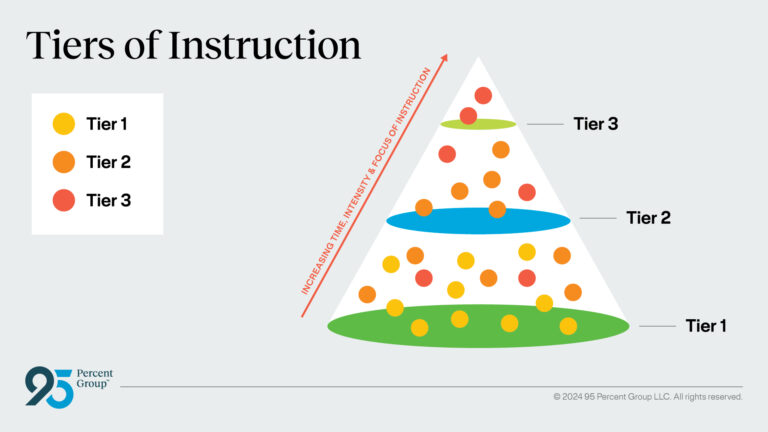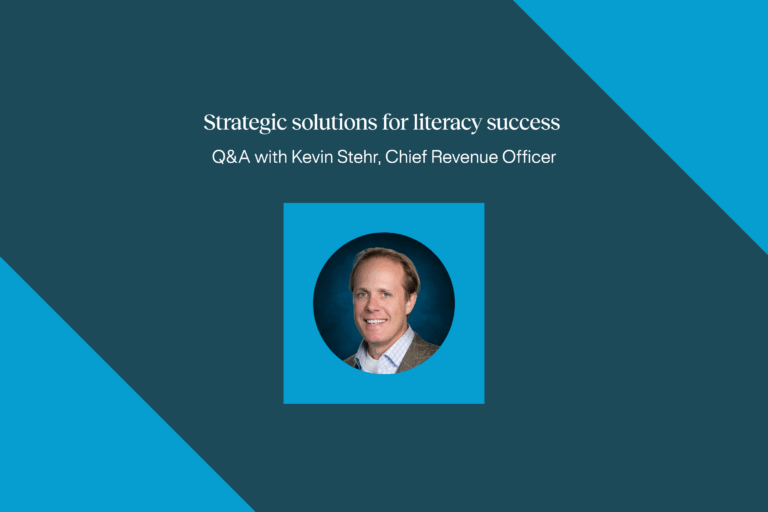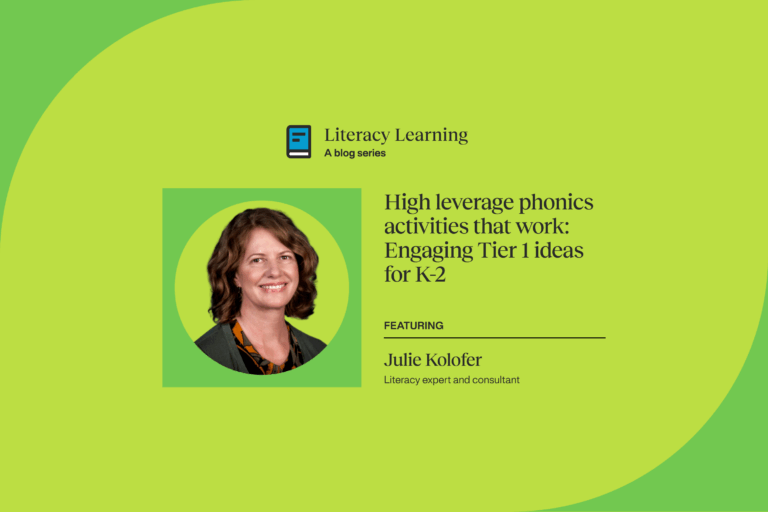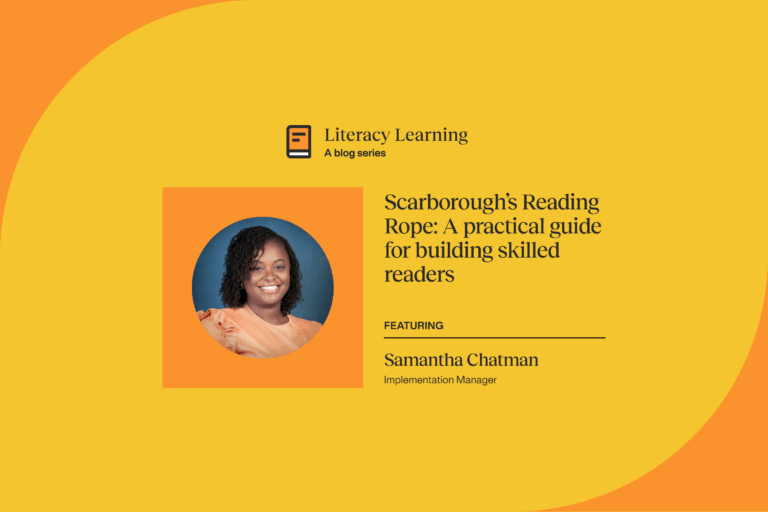Effective reading intervention strategies for educators
Our intervention guide explores common difficulties, diverse strategies, and tips for choosing & implementing successful solutions.

When students are struggling to master foundational literacy skills, reading intervention can be a powerful solution. Research has helped educators realize the vast majority of our students do not learn to read on their own and instruction really matters; in fact, most need explicit instruction (including phonics) in order to become capable readers.
In fact, we now know that while spoken language has been hardwired in human brains for at least 100,000 years, reading isn’t a skill that human brains are hardwired for, and thus, explicit and systematic instruction is necessary for much of the population.
While Tier 1 core instruction that is structured, explicit, and taught in a systematic and sequential manner will be sufficient for many students, some will need further reading intervention strategies. Let’s explore this idea.
What is reading intervention?
When we refer to reading intervention, it usually points to smaller groups of students receiving additional instruction because they need support with the basics of reading. Often, schools are working within a remediation model, which means that students that need additional support are pulled from their Tier 1, core instruction to work on skills they may not have mastered yet, while their classmates are working on grade-level skills.
Research has shown us that an acceleration model is actually more effective. This means students who need additional support (outside of Tier 1 instruction) are not pulled from core instruction to receive it. They receive intervention instruction in addition to their core literacy instruction–and the intervention materials and instruction are directly connected to the work they are doing in their core instruction. We know now that continuing to work on grade-level skills while providing additional intervention instruction for those students that need foundational skills support, moves the needle more effectively.
The different tiers of instruction represent who is receiving the instruction, as well as the time and intensity dedicated to the instruction. In general, all students participate in Tier 1, or core instruction. Students who have a need for more focused support according to diagnostic assessment data are provided with Tier 2 and Tier 3 instruction.
Let’s explore how to identify students who will need additional literacy support.
Recognizing the need for intervention
To best support all students on their path to successful literacy acquisition, it’s necessary to understand what students already know and what they need additional or in-depth instruction on.
Many schools screen all students at least once a year, but often more frequently, at the beginning of the year (BOY), the middle of the year (MOY) and the end of the year (EOY) using a Universal screener (Acadience, DIBELS, and AIMSweb are popular universal screeners). While this is a very useful tool and offers information about whether or not a student is at risk for reading difficulty, it doesn’t give specific information, nor does it offer help with making instructional support-based decisions.
In order to have the information that truly helps teachers to understand what their students need, and how to make confident, effective instructional decisions, a diagnostic assessment is imperative. The diagnostic assessment shows whether a student has mastered a specific set of skills and then offers steps to take to provide the necessary support. Importantly, a diagnostic assessment should pinpoint where on a continuum a skills intervention needs to begin and what lessons can provide that intervention. In other words, assessment, instruction, and resources should be seamlessly integrated for maximum efficiency.
95 Percent Group offers two different diagnostic assessments: the 95 Phonemic Awareness Screener for Intervention™ and the 95 Phonics Screener for Intervention™—each mapping directly to specific skill lessons inside our phonemic awareness or phonics program.
Start with student needs
There isn’t just one way to implement reading intervention strategies. However, the success of an intervention model does depend on the shared dynamics of student needs, staffing availability and accessibility of time and space. In the popular Multi-Tiered Systems of Support (MTSS) framework, this entails supporting students based on data showing whether they are reading on grade level or whether they need explicit skills instruction in addition to the core literacy instruction they are receiving.
Once you know your student’s needs, you can work to figure out what the best reading intervention strategies will be.
Choosing the right strategy
When you have collected and interpreted data and know which skills your students need additional support with, it’s time to choose the intervention strategies that make the most sense. A few questions to ask might include:
- What is the widespread need among our students?
Is it 20% of students reading just below grade level? Do 5% of those students need even more intensive support? What if the majority of students are not meeting benchmarks with Tier 1 instruction? If that is the case,do we need to re-examine our Tier 1 or do we need to implement a Walk-to-Read model where we are providing Tier 1 instruction in smaller, needs-based groups? - What are we capable of in terms of staffing?
Small groups with an interventionist? A “walk-to-intervention” model where all hands are on deck during intervention? - What kind of time do we have in our school day and school week?
Where does it make sense to offer this intervention? Can there be a whole school or grade-level “Walk to Read,” or “What I Need,” or “WIN” block where students spend time working on skills specific to their needs?
Once you have the framework in place, and understand what students need, they can be grouped accordingly. Using data to understand what type of reading intervention is necessary helps to ensure that students are receiving the explicit instruction that will offer the biggest impact on their learning. Different models work well for different schools and understanding your students’ and teachers’ needs is the first step to implementing the right reading intervention strategy.
If there are students who are missing foundational literacy skills, some of the intervention strategies might include instruction in:
- Phonemic awareness: Helps students have a better understanding of phonemes: the smallest sound units inside of a word. Effective instruction will also quickly associate sounds (phonemes) their representative letter(s) (graphemes)
- Decoding and Encoding: Decoding is what students need to do to translate printed language into speech. Doing this quickly and automatically is how students build the foundation necessary to be a successful reader. The purpose of this instruction is for students to be able to map sound-symbol relationships accurately so that words are stored for automatic retrieval, in essence, becoming “sight words.” (This process of orthographic mapping applies to all words, regular or irregular.) Decoding intervention should always include encoding as well, to secure the understanding of the code for spelling and writing.
These strategies help students read more automatically at the word level—a crucial factor in having the eventual cognitive space for comprehension and critical thinking.
For reading intervention that is focused more on reading comprehension, strategies will look a little different:
- Vocabulary and word study: An increased vocabulary ultimately offers students a depth and breadth of background knowledge—something that becomes incredibly important as they tacklemore sophisticated topics in subjects like History and Science. Vocabulary instruction includes both intentional or direct instruction on actual words and word meanings as well as teaching students strategies for independent vocabulary-building. We also want our classrooms to be language-rich to encourage our students to become “word wizards” who savor and explore vocabulary.
- Comprehension activities such as making connections and inferences, drawing conclusions, and understanding informational text features and the components of fiction are additional strategies to help students eventually be able to monitor their own understanding.
Putting intervention strategies into action
When you have a tiered system of instruction, it becomes easier to ensure that each student is getting the instruction they need to be reading on grade level.
Let’s look at 95 Percent Group’s One95 Literacy Ecosystem™ and how it can provide instructional strategies and materials at all levels.

Tier I
Tier I instruction refers to the core literacy instruction that all students receive. The hallmark of an effective Tier 1 program is a structured sequence delivered through explicit and direct instruction that offers student feedback and a scaffolded gradual release approach (I do, we do, you do). If the core instruction is effective, 80% of students should receive what they need to be grade-level readers.
Tier 2
Tier 2 instruction is intervention for the smaller number of students who score below the grade level benchmark and need increased time, intensity (smaller group size) and focus (targeted skills identified by diagnostic screeners) of instruction in addition to their Tier 1 literacy instruction. Tier 2 is also evidence-aligned enrichment and supports for students already at benchmark. It can also provide enrichment for Tier 1 instruction.
Tier 3
Tier 3 intensive intervention instruction is evidence-aligned and supports students not responding to Tier 2 instruction. It is highly individualized to already identified student needs. Our Tier 3 intervention instruction is based on our newly acquired product, 95 RAP™— a teacher-led, small group, digital solution for struggling readers, including those with dyslexia.
Additionally, Tier 3 instruction can offer extension and support for students well-above benchmark.
Check out this on-demand webinar for more information.
Reading intervention success stories
Below is an excerpt from a 95 Percent Group Intervention Success Story:
Fairfax School District is located in a small community on the southeast side of Bakersfield, in Kern County, California. The district currently has four schools (they’re adding a fifth) with a total of 2,688 students.
A true “walk to learn” model
Q: Can you talk a little more about the early implementation phase? You mentioned that when you trained all the aides, that decision wasn’t popular initially.
A: Charley Clark, Superintendent, Fairfax School District, CA:
Yes, it wasn’t a popular decision, but I asked them to trust me, and I assured them that if this doesn’t work, they can have them back. Of course it worked. We knew it was going to work. We created a schedule so we have a true “walk to learn” model. From 9 to 9:30 a.m., there are four kindergarten teachers, five aides, and a reading specialist. So that’s 10 people that are all hands on deck from 9 to 9:30 for the whole kindergarten. The lowest-performing kids go to the reading lab and we also have what we’re doing with the 95 Phonics Core Program®, and this is a great enrichment time for our higher-performing kids.
Then, there’s a 15-minute break and from 9:45 to 10:30 a.m., it’s first grade and the whole team travels. Now you have first grade teachers, those same aides, the reading specialist. With the model we did, working out details with schedules was always challenging, but it was a really focused way for teachers to get intervention for their kids as opposed to “Send your five lowest-performing kids” to our reading specialists.
The final word
The goal for literacy instruction remains that all children are receiving what they need in their Tier 1 reading instruction. But the reality is that there will be students who need, with certainty, more support than that instruction can offer. For these reasons, having a tool box of reading intervention strategies and intervention materials that are backed by the science of reading and based on evidence of efficacy is one way to make sure you are meeting the needs of all students you serve.
If you are interested in any of the intervention resources we have at 95 Percent Group, including the new and exciting digital Literacy Intervention System platform, and our extensive professional learning and coaching offerings, please contact us today!
Resources
- Moats, L. (n.d.). Whole-Language high jinks: How to tell when “Scientifically-Based reading instruction” isn’t. https://eric.ed.gov/?id=ED498005
- Liberman, I. Y., Shankweiler, D., & Liberman, A. M. (n.d.). The alphabetic principle and learning to read. https://eric.ed.gov/?id=ED427291
- Accelerated Learning. (n.d.). Michigan Department of Education. Retrieved March 8, 2024, from https://www.michigan.gov/-/media/Project/Websites/mde/Flexible-Learning-Options/Accelerated-Learning/AL-vs-Remediation/AL_v_Remediation.pdf?rev=535e57d7df0b498cae22789fd9d34f24
- Teaching sight words as a part of comprehensive reading instruction. (2023, May 16). Iowa Reading Research Center – the University of Iowa. https://irrc.education.uiowa.edu/blog/2018/06/teaching-sight-words-part-comprehensive-reading-instruction
- Pendharkar, E. (2023, October 13). MTSS: What is a Multi-Tiered System of Supports? Education Week. https://www.edweek.org/teaching-learning/mtss-what-is-a-multi-tiered-system-of-supports/2023/



